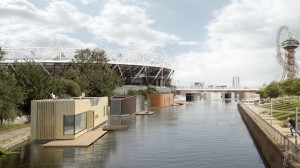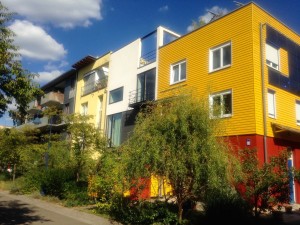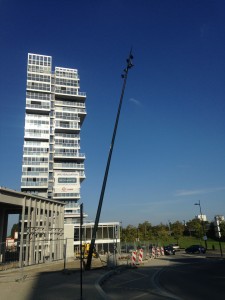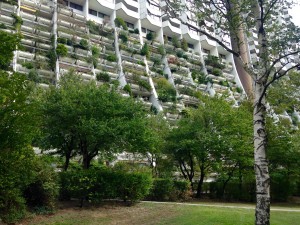
So the New London Architecture longlist of 100 ideas to solve London’s housing crisis is out! The categories of solution from the world’s finest minds appear to be: floating, densifying, bridging, mixing, doing-it-yourself, adding, relaxing, labelling, renting, standardising, superimposing, stacking and darning. I’m looking forward to the exhibition (starts October 15th) to see what all this really means. Approaching the end of my journey through European housing, four threads have run through my last month’s visits, picking up on some of these competition themes.
 First, it seems appropriate in this newborn era of ‘kinder’ political dialogue and collective thinking to mention some more self-starting, eco-driven schemes. I cannot help but admire the community activists who spend many unpaid hours making their own development schemes fly: doing it for a living is challenging enough. Freiburg’s Vauban district feels like the most successful of these (its high street was alive and thriving), with others (Spreefeld, Ginko Eco, Bottière) needing more time or help and probably a revisit in a few years. Cars and parking still dominate many discussions about, and designs for housing (even green communities), which is a shame but a reality. Vauban managed to attract enough residents who either did not own a car or were prepared to pay a premium to park it some way from their home. Could this ever work in the UK?
First, it seems appropriate in this newborn era of ‘kinder’ political dialogue and collective thinking to mention some more self-starting, eco-driven schemes. I cannot help but admire the community activists who spend many unpaid hours making their own development schemes fly: doing it for a living is challenging enough. Freiburg’s Vauban district feels like the most successful of these (its high street was alive and thriving), with others (Spreefeld, Ginko Eco, Bottière) needing more time or help and probably a revisit in a few years. Cars and parking still dominate many discussions about, and designs for housing (even green communities), which is a shame but a reality. Vauban managed to attract enough residents who either did not own a car or were prepared to pay a premium to park it some way from their home. Could this ever work in the UK?
 Second, mobility is my new favourite word, neatly combining that muddle of concepts road traffic, public transport, cycling and walking. Lyon, Bordeaux and Nantes have gone a long way to consider and implement improved intra-city mobility, with very regular trams being the dominant mode in France combined with fantastic new public realm. Many of the regeneration sites I have seen are created through the removal of railway lines, stations, airports and tram depots: so it would seem that transport infrastructure, even in its decline, is the driver for renewal in many ways.
Second, mobility is my new favourite word, neatly combining that muddle of concepts road traffic, public transport, cycling and walking. Lyon, Bordeaux and Nantes have gone a long way to consider and implement improved intra-city mobility, with very regular trams being the dominant mode in France combined with fantastic new public realm. Many of the regeneration sites I have seen are created through the removal of railway lines, stations, airports and tram depots: so it would seem that transport infrastructure, even in its decline, is the driver for renewal in many ways.  What’s interesting though is the potential impact of ‘macro-mobility’ i.e. new TGV or indeed Crossrail and HS1+2 lines: in improving inter-city connectedness, we are inevitably encouraging yet more land speculation and increasing property prices not just in London, but other parts of Europe as yet only lightly touched by Global Real Estate. Emerging masterplans near main city train stations are often dubbed ‘Eur-x’, demonstrating that they will be part of a trans-continental network, that they are new quarters of high-rise, mixed use, steel and glass monoliths designed by the stars and inhabited by Euro-business-people. If this must be, then let us always remember the locals, and not carelessly start more fires around our continent.
What’s interesting though is the potential impact of ‘macro-mobility’ i.e. new TGV or indeed Crossrail and HS1+2 lines: in improving inter-city connectedness, we are inevitably encouraging yet more land speculation and increasing property prices not just in London, but other parts of Europe as yet only lightly touched by Global Real Estate. Emerging masterplans near main city train stations are often dubbed ‘Eur-x’, demonstrating that they will be part of a trans-continental network, that they are new quarters of high-rise, mixed use, steel and glass monoliths designed by the stars and inhabited by Euro-business-people. If this must be, then let us always remember the locals, and not carelessly start more fires around our continent.
 Third, some of the NLA entries seem to suggest stand-alone, mixed-use megastructures, as we have seen successfully revived at e.g. the Brunswick Centre in London. I have been particularly stimulated by this idea in various formats and eras this month, including Alt Erlaa, Unité, Kabelwerk, and less successfully (but majestically) at Gallaratese. These big beasts seem to work better at high density in city centre locations, where the outside world can penetrate and add to the commercial flow.
Third, some of the NLA entries seem to suggest stand-alone, mixed-use megastructures, as we have seen successfully revived at e.g. the Brunswick Centre in London. I have been particularly stimulated by this idea in various formats and eras this month, including Alt Erlaa, Unité, Kabelwerk, and less successfully (but majestically) at Gallaratese. These big beasts seem to work better at high density in city centre locations, where the outside world can penetrate and add to the commercial flow.
 And fourth, the devil (and God) is always in the detail. Roger Hawkins in a seminar for Urban Design London recently reminded everyone that it’s the period after planning where the quality game is won or lost. Balconies, Awnings and Signage have particularly caught my eye on the continent, and provided inspiration and ideas: these have been some of my most-viewed posts as well!
And fourth, the devil (and God) is always in the detail. Roger Hawkins in a seminar for Urban Design London recently reminded everyone that it’s the period after planning where the quality game is won or lost. Balconies, Awnings and Signage have particularly caught my eye on the continent, and provided inspiration and ideas: these have been some of my most-viewed posts as well!

